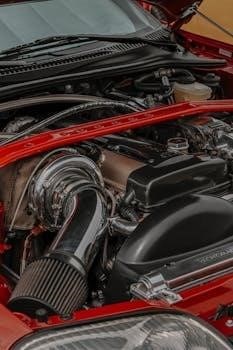
2016 Toyota Camry Maintenance Schedule Overview
Maintaining your 2016 Toyota Camry is crucial for its longevity and performance. A well-defined maintenance schedule‚ typically based on mileage or time intervals‚ helps ensure all components are functioning as intended; Following the recommended guidelines will keep your vehicle in optimal condition.
Routine Maintenance Intervals
The 2016 Toyota Camry’s maintenance schedule operates on a principle of regular‚ recurring service intervals to ensure optimal performance and longevity. These intervals are generally based on either mileage or time‚ whichever comes first. Typically‚ you’ll find service appointments recommended every 5‚000 miles or 6 months. The specific services performed at these intervals vary‚ but they often include essential checks and replacements. It’s important to adhere to these recommendations to keep your Camry running smoothly‚ avoid costly repairs and maximize the lifespan of your vehicle. Neglecting these intervals could lead to decreased performance‚ increased wear and tear‚ and potential safety risks.
5‚000 Miles/6 Months Service
At this interval‚ your 2016 Toyota Camry requires basic maintenance. This includes fluid level checks‚ wiper blade inspection‚ tire rotation‚ and brake inspection. It is essential for the proper functioning of the vehicle.
Inspection of Fluid Levels and Wiper Blades
During the 5‚000-mile or 6-month service‚ inspecting all fluid levels is a critical step. This includes checking engine oil‚ coolant‚ brake fluid‚ power steering fluid‚ and windshield washer fluid. Ensuring these fluids are at their proper levels is essential for the vehicle’s smooth operation and safety. Additionally‚ wiper blades should be carefully examined for wear and tear. Damaged or worn blades can significantly reduce visibility during inclement weather. Regular inspection helps maintain clear visibility.
Tire Rotation and Brake Inspection
At each 5‚000-mile or 6-month service interval‚ tire rotation is an important procedure. This helps to ensure even wear across all tires‚ maximizing their lifespan and maintaining optimal traction. Alongside tire rotation‚ a thorough brake inspection should also be conducted. This includes checking brake linings‚ drums‚ pads‚ and discs for any signs of wear or damage. Identifying and addressing brake issues early is crucial to ensure safety and prevent costly repairs down the line. Regular checks of the braking system are paramount.
10‚000 Miles/12 Months Service
Reaching the 10‚000-mile or 12-month mark requires a more comprehensive service. This includes critical maintenance to keep the vehicle running efficiently and safely. It is important not to skip this service.
Cabin Air Filter Replacement
The cabin air filter in your 2016 Toyota Camry should be replaced at the 10‚000-mile or 12-month service interval. This filter is responsible for cleaning the air entering the passenger compartment‚ removing dust‚ pollen‚ and other pollutants. Over time‚ the filter can become clogged‚ reducing its efficiency and potentially affecting the air quality inside the vehicle. Regular replacement ensures that the air you breathe inside the Camry is clean and fresh‚ contributing to a more comfortable and healthy driving experience. Ignoring this service may lead to reduced airflow and increased allergens within the car.
Engine Oil and Oil Filter Change
A crucial part of the 10‚000-mile or 12-month service for your 2016 Toyota Camry is the engine oil and oil filter change. Engine oil lubricates the engine’s moving parts‚ reducing friction and preventing wear. Over time‚ the oil degrades and becomes less effective at protecting the engine. The oil filter removes contaminants from the oil‚ preventing them from circulating through the engine. Regularly replacing both the oil and the filter helps maintain optimal engine performance‚ extends engine life‚ and ensures your Camry runs smoothly and efficiently. This maintenance task is vital for your vehicle’s overall health.

15‚000 Miles/18 Months Service
At 15‚000 miles or 18 months‚ your 2016 Toyota Camry requires a more detailed inspection. This service ensures key components are functioning correctly and maintains the vehicle’s reliability.
Detailed Inspection of Key Components
During the 15‚000-mile or 18-month service‚ a thorough examination of several key components is necessary for your 2016 Toyota Camry. This includes inspecting ball joints and dust covers‚ brake lines and hoses‚ and drive shaft boots. Furthermore‚ the engine coolant‚ exhaust pipes and mountings‚ radiator and condenser‚ steering gear‚ and steering linkage and boots should also be carefully assessed. If your Camry is a 4WD model‚ the rear differential oil or transfer case oil should be inspected as well‚ ensuring all vital parts are in good working order.

30‚000 Miles/36 Months Service
At 30‚000 miles or 36 months‚ your 2016 Toyota Camry requires a comprehensive service. This includes replacing filters and inspecting critical systems to maintain optimal performance and longevity.
Engine and Cabin Air Filter Replacement
Replacing both the engine and cabin air filters is a key part of the 30‚000-mile service for your 2016 Toyota Camry. The engine air filter ensures that clean air flows to the engine‚ promoting optimal combustion and fuel efficiency. A clogged filter can negatively impact performance. Simultaneously‚ replacing the cabin air filter will help maintain a healthy environment inside the car by removing dust‚ pollen‚ and other contaminants‚ ensuring good air quality for all passengers.
Transmission and Fuel Line Inspection
At the 30‚000-mile mark‚ a thorough inspection of the transmission and fuel lines is vital for your 2016 Toyota Camry. This check helps ensure the smooth operation of your vehicle. The transmission inspection looks for any leaks‚ damage‚ or signs of wear‚ which could lead to shifting problems. Simultaneously‚ inspecting the fuel lines is essential to identify any potential leaks or damage that might pose a safety risk or affect fuel efficiency. Catching these issues early can prevent more significant and costly repairs.
100‚000 Mile Service
Reaching 100‚000 miles requires a comprehensive service for your 2016 Toyota Camry. This milestone check includes specific maintenance tasks to ensure continued reliability and performance. It’s a crucial point in your car’s lifespan.
Specific Maintenance Tasks at 100‚000 Miles
At 100‚000 miles‚ your 2016 Toyota Camry needs a thorough check-up. This includes inspecting and potentially replacing spark plugs‚ which are essential for engine performance. Additionally‚ a comprehensive inspection of the cooling system‚ including the radiator and hoses‚ is necessary. It’s vital to examine the drive belts for wear and tear‚ and fluids like transmission fluid and coolant should be replaced to ensure optimal operation. Furthermore‚ a detailed brake inspection and possible replacement of brake components‚ depending on their condition‚ should be performed. These tasks are not optional to maintain the car’s safety and performance.
Additional Maintenance Considerations
Besides the regular schedule‚ consider factors like driving habits and environment. These can impact service needs. Be aware of brake pad wear and the benefits of extended warranties for peace of mind.
Brake Pad Replacement
Brake pad wear is a crucial aspect of vehicle maintenance. While routine inspections are part of the standard schedule‚ the lifespan of your brake pads can vary depending on driving habits. Rear brake pads‚ in particular‚ may wear down faster than front pads‚ and require more frequent checks. It’s important to consult your 2016 Toyota Camry maintenance schedule for specific recommendations on inspection and replacement intervals. Regular attention to your braking system will ensure safe and reliable vehicle operation. Be sure to address any squealing or grinding noises promptly‚ as these can signal the need for replacement.
Extended Warranty and Prepaid Maintenance
Considering an extended warranty or prepaid maintenance plan for your 2016 Toyota Camry is a smart move for long-term ownership. These plans can offer peace of mind by covering potential repairs beyond the standard warranty period‚ and can also lock in costs for routine services. Prepaid maintenance plans typically cover basic services like oil changes and tire rotations‚ ensuring your car is properly maintained at a known price. Toyota Financial Services offers extended warranty plans‚ so that you can have the security knowing your vehicle is covered for unforeseen issues. Carefully evaluate your driving habits and ownership plans to decide if they are right for you.

Cost and Reliability
The 2016 Toyota Camry is known for its reliability and reasonable maintenance costs. Owners can expect lower than average expenses for both routine servicing and potential repairs‚ compared to other sedans in its class.
Average Maintenance Costs
The 2016 Toyota Camry typically incurs lower maintenance expenses than the average sedan‚ with about $4‚455 spent on maintenance and repairs during the first ten years of service. This contrasts favorably with the industry average‚ which is about $1‚506 higher. This suggests a long-term saving. These estimates are based on a combination of regular servicing‚ like oil changes and tire rotations‚ along with any potential repairs that might arise. Because of this‚ the Camry is considered to be an economical vehicle to maintain over its lifespan.
Probability of Major Repairs
The 2016 Toyota Camry demonstrates a lower likelihood of requiring major repairs compared to other vehicles in its class. Specifically‚ there’s an approximate 11.89% chance of a major repair within the first ten years of ownership. This is notably 4.92% better than similar vehicles‚ highlighting the Camry’s reliability. This lower probability is a significant factor that contributes to the car’s overall cost-effectiveness. A “major repair” is typically considered anything exceeding $500 for parts and labor. This data is compiled from industry leading data providers.

Toyota Warranty Information
Toyota provides several warranties for the 2016 Camry‚ including a new vehicle limited warranty and coverage for accessories. There is also specific coverage for hybrid components‚ which is more extensive.
New Vehicle Limited Warranty
The 2016 Toyota Camry comes with a new vehicle limited warranty that provides coverage for a specific period or mileage‚ whichever comes first. This warranty typically includes bumper-to-bumper coverage for defects in materials or workmanship. It’s important to review the specific terms and conditions outlined in your warranty booklet to understand what’s covered and what’s excluded. This warranty is designed to protect you from unexpected repair costs within the warranty period‚ giving you peace of mind during the initial years of ownership. The length of this warranty may vary‚ so always refer to your vehicle’s specific documentation.
Accessory Warranty
Toyota accessories purchased at the time of your new 2016 Camry purchase are typically covered under the Toyota Accessory Warranty. This warranty usually extends for 36 months or 36‚000 miles from the vehicle’s in-service date‚ mirroring the coverage of the New Vehicle Limited Warranty. However‚ accessories bought after the initial vehicle purchase may have different warranty terms. It is important to keep purchase records and warranty information for any add-on items. Always refer to your accessory warranty documentation for full details on coverage and exclusions‚ ensuring you understand the protection provided for your Toyota accessories.
Hybrid Component Coverage
For 2016 Toyota Camry Hybrid models‚ specific hybrid-related components receive extended warranty coverage. This includes vital parts like the high-voltage (HV) battery‚ battery control module‚ hybrid control module‚ and the inverter with converter. Typically‚ these components are covered for 8 years or 100‚000 miles‚ whichever comes first. Furthermore‚ the HV battery itself may have extended coverage under emissions regulations in some regions‚ so it’s important to check your specific warranty information and local regulations. Always keep your warranty documentation readily available for future reference to ensure you fully understand your vehicle’s coverage.